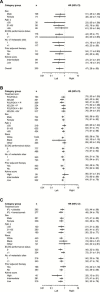Primary tumor location as a prognostic factor in metastatic colorectal cancer
- PMID: 25713148
- PMCID: PMC4565528
- DOI: 10.1093/jnci/dju427
Primary tumor location as a prognostic factor in metastatic colorectal cancer
Abstract
Background: We sought to clarify the prognostic impact of primary tumor location in metastatic colorectal cancer (mCRC).
Methods: We evaluated the association between tumor location and survival parameters in patients with previously untreated mCRC receiving first-line chemotherapy ± bevacizumab in three independent cohorts: a prospective pharmacogenetic study (PROVETTA) and two randomized phase III trials, AVF2107g and NO16966. Cancers proximal or distal of the splenic flexure were classified as right-sided or left-sided, respectively. The primary end point was overall survival (OS). Data were analyzed with Cox proportional hazards and logistic regression models. All statistical tests were two-sided.
Results: Among evaluable patients in the PROVETTA (n = 200), AVF2107g (n = 559), and NO16966 (n = 1268) studies, 72.0%, 63.1%, and 73.7% had left-sided tumors, respectively. In PROVETTA, patients with left-sided tumors had superior OS (left-sided vs right-sided: hazard ratio [HR] = .44, 95% confidence interval [CI] = .28 to .70, P < .001) and progression-free survival (HR = .52, 95% CI = .36 to .75, P < .001) outcomes. Multivariable analyses confirmed right-sided location as a negative prognostic variable, independent of mucinous histology and BRAF mutational status. Data from the AVF2107g (HR for OS = .55, 95% CI = .43 to .70) and NO16966 trials (HR for OS = .71, 95% CI = .62 to .82 both P < .001) also showed favorable outcomes in patients with left-sided tumors. In both randomized studies, the efficacy of bevacizumab was independent of tumor location.
Conclusions: These data demonstrate that primary tumor location is an important prognostic factor in previously untreated mCRC. Given the consistency across an exploratory set and two confirmatory phase III studies, side of tumor origin should be considered for stratification in randomized trials.
© The Author 2015. Published by Oxford University Press. All rights reserved. For Permissions, please e-mail: journals.permissions@oup.com.
Figures


Comment in
-
The bipartisan colon.J Natl Cancer Inst. 2015 Feb 24;107(3):djv011. doi: 10.1093/jnci/djv011. Print 2015 Mar. J Natl Cancer Inst. 2015. PMID: 25713149 No abstract available.
-
RE: Primary Tumor Location as a Prognostic Factor in Metastatic Colorectal Cancer.J Natl Cancer Inst. 2015 Sep;107(9):djv207. doi: 10.1093/jnci/djv207. J Natl Cancer Inst. 2015. PMID: 26376497 Free PMC article. No abstract available.
-
RE: Primary Tumor Location as a Prognostic Factor in Metastatic Colorectal Cancer.J Natl Cancer Inst. 2015 Sep;107(9):djv203. doi: 10.1093/jnci/djv203. J Natl Cancer Inst. 2015. PMID: 26389156 Free PMC article. No abstract available.
References
-
- Van Schaeybroeck S, Allen WL, Turkington RC, Johnston PG. Implementing prognostic and predictive biomarkers in CRC clinical trials. Nat Rev Clin Oncol. 2011;8(4):222–232. - PubMed
-
- George B, Kopetz S. Predictive and prognostic markers in colorectal cancer. Curr Oncol Rep. 2011;13(3):206–215. - PubMed
Publication types
MeSH terms
Substances
Grants and funding
LinkOut - more resources
Full Text Sources
Other Literature Sources
Medical
Research Materials

